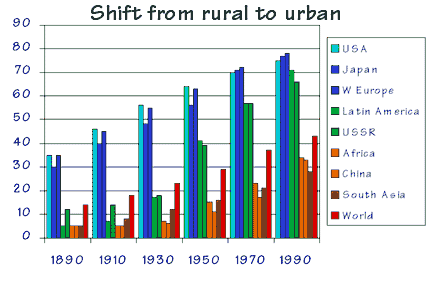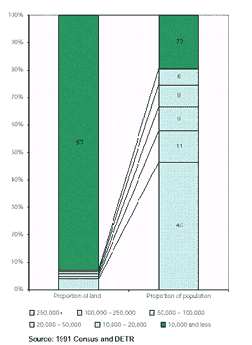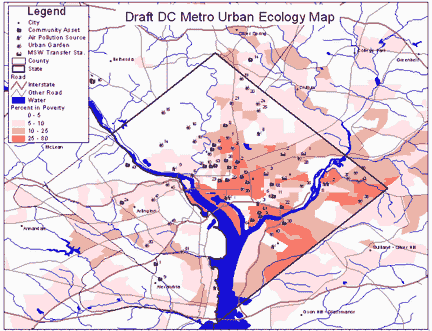 |
||
|
The shift from urban to rural |
THE SHIFT FROM RURAL TO URBAN
The last two centuries have seen an urban explosion Rural depopulation has a link to the necessity of migrating to urban employment (in factories etc.) but the reduction in the number of small settlements or hamlets in England (over 800 in the last 1000 years) points to an earlier cause and indicates instead that a widespread de-skilling occurred first, through a dislocation and disconnection between the populace and their ability to undertake primary land use. Thus it may have been an enforced shift of rural populations to urban centres as their access to land was denied (perhaps the widescale plague of medieval times that reduced the population of rural workers was a significant early factor, followed by the pressure to clear land to use for sheep). Land use changed from employment mixed with self-production to solely employment to produce for others. This accelerated during the 18 and 19th centuries due to the rise of large area land ownership and use, brought about by land robbing in Enclosure Acts and through the highland clearances in Scotland. Now, national planning policies maintain the division between the urban and rural, but with the force of law as well as by ownership. Rural planning policies that restrict resettlement in rural areas maintain a barrier on the basis of a high entry price. These high prices are maintained by the artificial scarcity of buildings and building land caused by over-protection of unremarkable rural land.
Peri-urban and intra-urban humanscale agriculture
can be shown to have existed on
the good soils around the settlements
that expanded with this influx from the rural. This is
not surprising since all settlements naturally make use of the resources
close to their home, giving them a measure of self-reliance that meant
they were not wholly dependent on a remote, rural hinterland.
Unfortunately, the ever-rising urban population caused the successive
loss of this land, taking away that opportunity for a measure of urban
self-reliance. These pressures continue today,
with the loss of any open space in urban areas to dense housing, without
there being any compensatory increase in access to rural land.
The transition to a predominantly urban populace de-links us from the primary means for sustainability. This new urbanism also brought with it problems of public health: traditional practices of dealing with human and other wastes were incompatible with the higher density living and led to the need for collaborative large scale solutions (piped potable water, street drainage, sewerage systems etc.). Across the whole range of human sustainability, we therefore have to compromise with our natural instincts, having to make the most of our urban location in creative ways, while decrying the inequalities that exist in our access to land. What makes it harder to accept is that there is a popular perception that Britain is an overcrowded island. This denies the reality that 20% of our population live in settlements of 10,000 and less, and they get to occupy 93% of our land. The other 80% get to live in enforced density on the remaining 7% of our land (see the figure) -topWHAT IS URBAN SUSTAINABILITY? The concept of urban sustainability is closely linked to that of sustainable development, which became a subject of world-wide discussion after the United Nations report Our Common Future (1987) and the first earth summit in Rio, 1992. We can define as sustainable any form of development that satisfies the needs of the present without compromising the ability of future generations to satisfy theirs. As could be predicted, it is becoming increasingly unlikely that the planet is capable of absorbing our waste indefinitely or that we can go on exploiting energy resources - such as fossil fuels - thinking that they are inexhaustible. This kind of attitude, distinguished understandably as a measure of progress in the last two centuries, would seem now to jeopardise the futures of our children and grandchildren.Our use of technology in exploiting material and energy resources has been characterised by a reasoning and a presumption that fitted the needs and the ideology of the time. We have put to our own use a huge mass of machinery, which is harnessed to satisfy diverse needs - transport, heating or cooling, entertainment, production of materials, wealth etc. The annual world consumption of energy comes to around 8 billion ETP (equivalent tonnes of petroleum) which, translated into terms of human labour, is equal to the work done by the hands of 100 billion labourers. The industrialised countries (USA, Western Europe, Japan – a quarter of global population) account for around 80% of total energy consumption. Thus if we translate this energy usage in human labour terms for the individuals of those industrialised countries, it comes to each person having at their disposal the work of roughly 80 manual labourers. The use of a car would translate to a carriage being drawn by 100 live horses. Another way of characterising urban resource use is the model of footprints which relates the area of primary-production land needed to support the resource use of dwellers on urban land. The ratio in favour of urban dwellers for various commodities can be startlingly high, and there is an urgent presumption to reduce that footprint. But let us not forget that by their very nature, centres of urban density will implicitly have large footprints. It may not be entirely logical to denigrate cities when their populace is denied simple self-reliant options to reduce their footprint. WHAT IS URBAN ECOLOGY? Cities and residential areas are the scene of a huge turnover of raw materials, energy and other resources that generate issues of environmental impact. There is no question that a future urban development model with lower ecological impact will pose many questions of change and transition towards a new kind of development, in which nature and its resources will have to be given more serious consideration. Many manufacturing processes will have to be modified, many products recycled, new forms of technology developed and many old habits altered or abandoned. In many countries, and in some international organisations, there is now a broad political consensus on the need for sustainable development of cities and human settlements. However, the new concepts and tools needed to carry out the changes are still being created and proved. The concept of urban ecology becomes one of the crucial tools in this process. Urban ecology has many different definitions, one of which is the interaction between people and the environment in urban and residential contexts, including the inter-relationship between natural and artificial flows of energy and natural resources. Thinking and acting in an ecologically sustainable manner effectively implies:
It is therefore necessary to assess the flow and circulation of raw materials at all levels of use - individual, in local communities and overall in cities – and adapt their use accordingly. This involves a wide-scale process of transition which is unlikely to take place overnight. Housing estates, streets, factories and power stations cannot simply be transformed or removed. The transition towards an urban ecology can thus only be based on the present state of our cities and consist of urban renewal and new building activities as well as the planning of the technical infrastructure for energy, water, the treatment of waste water and the recycling of waste. We must look at the life span of products and their capacity for being re-used, the availability of open space and to our mobility within it, and to the quality of housing. In all this, technology can play a vital role: planning for a sustainable future can indeed be substantially enhanced by the rational, social application of technology and from a deliberated consensus on what is appropriate technology. We must also look at the possibility of creating new employment in the area of socially and ecologically useful jobs (right livelihood). We must recognise all those contradictions involving the co-existence of people, which have erupted more dramatically in recent years in the wake of crises in employment, welfare and in the increasing social exclusion of a proportion of the urban population. BARRIERS TO URBAN SUSTAINABILITY Four different barriers can impede the application and development of sustainable solutions in urban ecology:
-topMAKING A START IN URBAN ECOLOGICAL PLANNING The European Awareness Scenario Workshops that are looked at briefly (see FUTURES) show a way for representative stakeholders from communities to begin to work through and understand the energy and material flows in their urban ecology, and to decide how they could be reshaped into the future and who should take responsibility. The workshops assumed a level of preparation on the part of the attendees who would have been given the scenarios beforehand and probably also sets of local data to ingest. In the short time of the two days of the workshops, enough material would be produced to write an action plan.
Another approach takes a
longer route, but has the merit that it is able to involve more and varied
people over time, and can directly address the cultural and some of the
political barriers to urban sustainability mentioned above. It is more
accessible. The approach is to build up a series of urban ecology
maps of your location. They can show many of the The example shown is of the DC Metropolitan Urban Ecology Map, a project of Sustainable Community Initiatives and the DC Metro Chapter of Architects, Designers and Planners for Social Responsibility. It shows the location of community assets, urban gardens, watercourses, air pollution sources, roads and waste transfer depots, and is overlaid with information about relative poverty in areas. The purpose of the map is to help in identifying areas of concern that might enable the DC community to work together more closely. It is hoped that the map will be a mechanism that contributes to stronger relationships between community leaders, and will educate people about a wealth of assets in that community that don't typically appear on maps - and will also identify some negatives that may not be apparent. The information on the map is descriptive of their communities in a way that stimulates thought about linkages, and discussion about the relationships between the organisations and institutions that shape the place they live in. From there, future development in those communities can be shaped within the realms of urban design. Mark Fisher - Permaculture Design course handout notes www.self-willed-land.org.uk mark.fisher@self-willed-land.org.uk |
 resulting from the relative depopulation of rural areas
resulting from the relative depopulation of rural areas 
 following: the trends in population growth and new building and the
distribution of population; energy usage and production; areas of high
water consumption and waste water; solid waste and its disposal; green
belts and agriculture; means of transport and traffic etc. These maps help
create new ways of thinking about and seeing communities by emphasising
the urban ecological mix, and celebrating the experience of where you
live.
following: the trends in population growth and new building and the
distribution of population; energy usage and production; areas of high
water consumption and waste water; solid waste and its disposal; green
belts and agriculture; means of transport and traffic etc. These maps help
create new ways of thinking about and seeing communities by emphasising
the urban ecological mix, and celebrating the experience of where you
live.